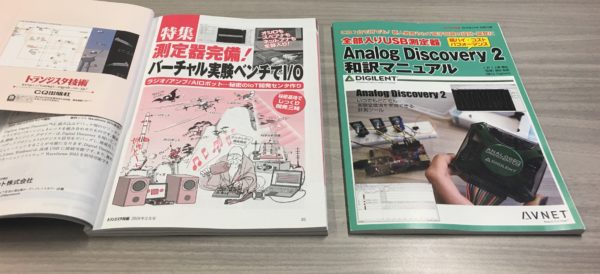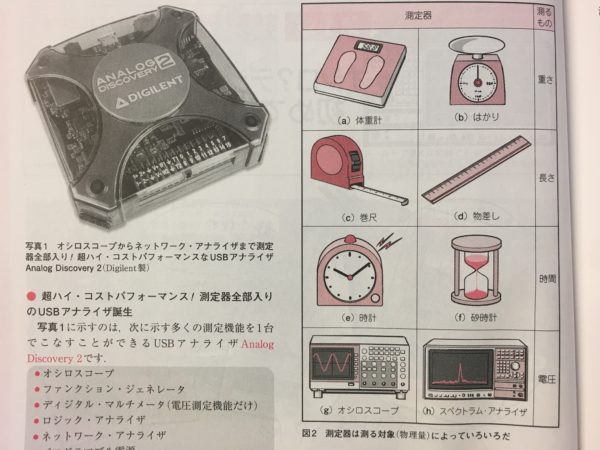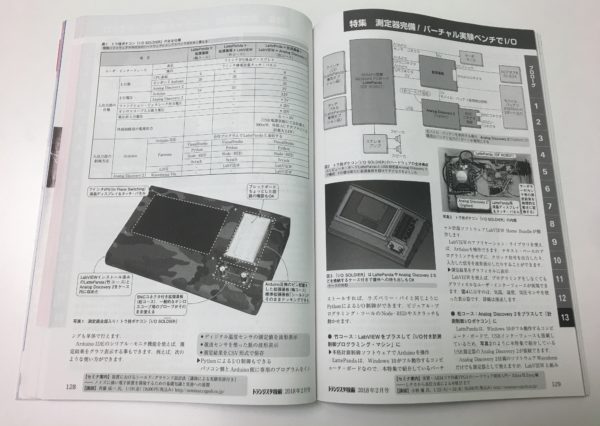This month the Analog Discovery 2 received some special attention in Japan with a big February feature in Toragi Magazine. The featured 100+ page article begins with a quick introduction to measurement tools, elaborating on the usefulness of devices such as spectrum analyzers and oscilloscopes, walking through various tools and device functionality, and concluding with a review of high-end application possibilities. An evaluation copy of LabVIEW 2017 was also provided, expanding the development potential and application use for the Analog Discovery 2 with additional programming uses described in the latter part of the feature.
Continue reading below for a brief review of the Toragi Magazine feature (translated from Japanese) and new information about an upcoming release that we will be announcing soon on the Digilent Store!
The February 2018 Analog Discovery 2 feature in Toragi Magazine begins with an brief introduction to Instrumentation tools. After comparing their use to other important measurement tools (i.e. bathroom scales for weight and an hourglass for time) the authors quickly expand on the usefulness of oscilloscopes and spectrum analyzers, both of which can be found on the Analog Discovery 2, when measuring or observing voltage in electronics projects. Instrumentation device capabilities are then further expanded upon with the use of LabVIEW 2017 to support project measurement needs.
Following a brief introduction of the usefulness of various benchtop tools and software applications, the article discusses basic circuit principles like ghost voltages, or hidden capacitance parts, which can be invisible to targets and other measuring instruments. The authors discuss solutions to possible circuit issues with the use of the Analog Discovery 2’s Impedance Analyzer tool, which helps account for unwanted parasitics (unlike quick measurements taken with a digital multimeter). This basic understanding of circuits is supported with two succeeding chapters that lead users through taking a correct oscilloscope measurement and review the proper ways for connecting the Analog Discovery 2 leads.
 An introduction to the world of LabVIEW is then provided as the authors discuss the process of setting up the software, entering a signal to observe, viewing the frequency spectrum, and graphing the data. Having setup the evaluation copy of the complimentary LabVIEW 2017 software, the authors begin expanding on project possibilities by creating an I/O experiment bench with the addition of an Arduino Uno. This assembly provides an inexpensive solution for a spectrum analyzer project in Chapter 8 that readers can engineer at home. To conclude this 100+ page article, the authors explore advanced project possibilities for the Analog Discovery 2 and LabVIEW 2017, including a taste analyzer project (using the Analog Discovery 2 and LabVIEW to create a titration machine), a project for extending the professional uses of the Analog Discovery 2 (e.g., building benchtop equipment with greater functionality), and more! Each project and circuits described are also supported in various appendixes throughout the feature for readers who wish to follow along and advance in their electronics journey.
An introduction to the world of LabVIEW is then provided as the authors discuss the process of setting up the software, entering a signal to observe, viewing the frequency spectrum, and graphing the data. Having setup the evaluation copy of the complimentary LabVIEW 2017 software, the authors begin expanding on project possibilities by creating an I/O experiment bench with the addition of an Arduino Uno. This assembly provides an inexpensive solution for a spectrum analyzer project in Chapter 8 that readers can engineer at home. To conclude this 100+ page article, the authors explore advanced project possibilities for the Analog Discovery 2 and LabVIEW 2017, including a taste analyzer project (using the Analog Discovery 2 and LabVIEW to create a titration machine), a project for extending the professional uses of the Analog Discovery 2 (e.g., building benchtop equipment with greater functionality), and more! Each project and circuits described are also supported in various appendixes throughout the feature for readers who wish to follow along and advance in their electronics journey.
While you can order the magazine on the Toragi website, please note that no English translation is available when purchasing. The February 2018 issue does however arrive with a separate volume appendix translating the Analog Discovery 2 reference manual from its original English version available on the Digilent Wiki.
We are so excited about this feature that we will be releasing a new bundle including the Analog Discovery 2 and LabVIEW. Stay tuned for an upcoming announcement on the Digilent Blog as we prepare to launch this exciting bundle in the next several months, offering you a new way to support your professional project development!




